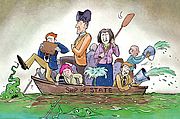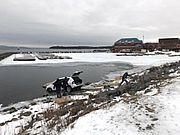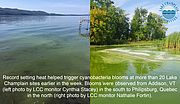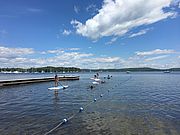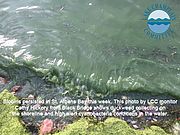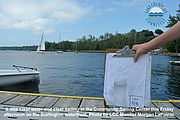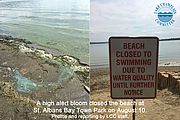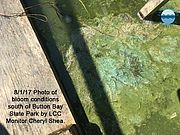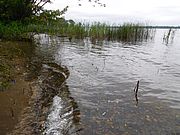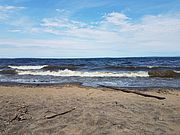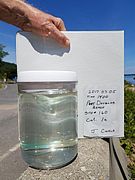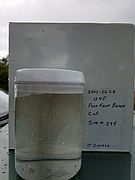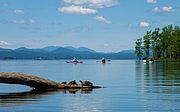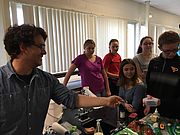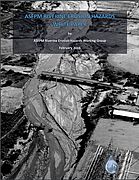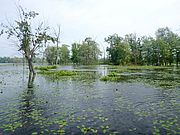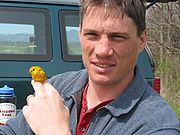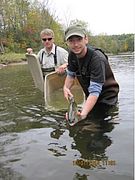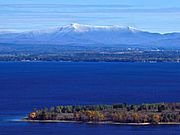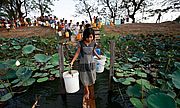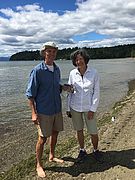“It appears the Vermont legislature will join Gov. Phil Scott in delaying again any decision on how to raise millions in new revenue to pay for Vermont's billion-dollar cleanup of its waterways. Environmental advocates and federal regulators are looking on with increasing concern."
Read...News from Selected Month
Vermont officials' refusal to share their stormwater document leaves unanswered questions about how the state is — or isn’t — working toward its commitments on water quality. Read more in this Seven Days article that outlines the Lake Champlain Committee and VNRC’s request for answers. Read...
"It sounds like a scene from a movie -- friends from Connecticut on a ski vacation in Vermont get lost, turn on their GPS, and next thing you know they are driving on a lake as the car is sinking. Well, that's exactly what happened” Read...
From September 24 through mid-week, a record-setting heat wave helped spawn or perpetuate blooms at over 20 monitoring sites along the Lake Champlain shoreline. The wet spring and summer had already flushed lots of nutrients into our waterways priming conditions for cyanobacteria to take off during the spate of hot, still weather.
Read...Mixed conditions were reported by Lake Champlain Committee (LCC) monitors again this week on Lake Champlain and inland lakes. Cyanobacteria blooms persisted in St. Albans Bay and Lake Carmi and in parts of Missisquoi Bay. Low alert conditions were observed at some Main Lake North and Main Lake Central sites and at Shelburne Pond.
Read...Mixed conditions were reported by Lake Champlain Committee (LCC) monitors yet again on Lake Champlain and inland lakes. Cyanobacteria blooms persisted in St. Albans Bay and parts of Missisquoi Bay and Main Lake North along with Lake Carmi. Low alert conditions were reported at Lake Memphremagog and Lake Morey.
Read...Monitors reported mixed conditions again this past week on Lake Champlain and inland lakes. Summer is on the wane and many state and municipal beaches are closed or will be closing soon, however LCC will continue to send weekly reports through the end of the month. Please be cautious while recreating on the water as blooms may persist through the reporting season.
Read...As we head into the Labor Day weekend LCC monitors are reporting both clear water and cyanobacteria blooms. While there are many beaches open and safe for swimming, we have received reports of blooms in Bulwagga Bay, Maquam Shore, St. Albans Bay, Missisquoi Bay, Lake Carmi, Shelburne Pond and Ticklenaked Pond.
Read...Lake Champlain Committee (LCC) cyanobacteria monitors mainly reported good conditions this week. The exceptions so far are low alerts from Monday August 21 at Philipsburg Quebec. The Quebec reports were from research sites that are monitored every two weeks so conditions may change well before the tracker gets updated with the next report. The other low alert came from Ticklenaked Pond in Ryegate in Vermont's Northeast Kingdom. There was also a report of an unusual cyanobacteria on Lake Morey in Fairlee, Vermont. Scroll down to see a picture of Rivularia spp. and learn more.
Read...While blooms witnessed on Lake Champlain were restricted to Missisquoi Bay (one location) and St. Albans Bay (four sites), we are still at the peak bloom period for our region. Spring and summer rains have flushed lots of nutrients into the water and temperatures are predicted to rise through the beginning of next week.
Read...This week there were mixed conditions reported on Lake Champlain but only one report of a bloom at Vermont inland lakes (low alert at Ticklenaked Pond) that participate in the monitoring program. While blooms witnessed on Lake Champlain were restricted to Missisquoi Bay (one location), St. Albans Bay (four sites), Inland Sea (two sites) and the northern part of the lake (one location), we are in the middle of what is generally the peak bloom period for our region.
Read...cyanobacteria monitors filed a record 171 reports this week from Lake Champlain and inland lake locations. Most sections of Lake Champlain experienced mixed conditions with both low and high alert blooms for at least some sites. The exceptions were Malletts Bay and the South Lake which reported generally good conditions at all sites but had fewer reports overall. Conditions can change rapidly and blooms can show up anywhere on the lake. Please be watchful, report anything of concern and avoid cyanobacteria.
Read...There was one report of low alert conditions in South Alburgh but that was short-lived and the water was clear the next morning. All other monitors reporting this week noted good conditions on Lake Champlain and other waterways in the program!
Read...We had a great response from Lake Champlain Committee (LCC) cyanobacteria monitors this week with 135 reports for Lake Champlain and inland lake locations! While it's been a week with lots of lovely summer weather, all the sunshine is encouraging cyanobacteria activity. Alert conditions were reported at Lake Champlain sites at Pt. Au Roche State Park beach and Black Bridge in St. Albans Bay as well as at Lake Carmi, Lake Amherst and Ticklenaked Pond.
Read...Monitors generally reported good conditions during another wet week. While Deep Bay at New York's Pt Au Roche State Park had a low alert bloom on 7/10, it had cleared by the next day. (Pt Au Roche had a short-lived bloom around the same time last year.) As of late Friday afternoon (7/14/17) there were no blooms at any of the Lake Champlain monitoring sites that reported this week.
Read...We had reports from 122 different Lake Champlain Committee cyanobacteria monitoring sites this week as of late afternoon on Friday. There were no reports of blooms on Lake Champlain, Lake Iroquois, Lake Memphremagog, and several other VT lakes but unfortunately the bloom at Shelburne Pond's boat launch persists at low alert levels.
Read...We had reports from 105 different sites this week as of mid-afternoon today. There were no reports of cyanobacteria blooms from monitoring sites on Lake Champlain, Lake Carmi, Lake Iroquois, Lake Memphremagog, and several other VT lakes but unfortunately Shelburne Pond experienced a high alert bloom at the boat launch.
Read...We had reports from 54 different sites this week. We will see an increase in the number of site reports as the season progresses and more of our monitors get out on the water. There were no reports of cyanobacteria blooms from monitoring sites on Lake Champlain, Lake Iroquois, Lake Memphremagog, and several other VT lakes.
Read...On average, synthetic fleece jackets release 1.7 grams of microfibers each wash, which equates to an average of 80,000 microfibers.
Read...As state legislatures struggle to take action on long-term funding for water protection and the Trump Administration proposes radical cuts to environmental programs, Doug Facey ponders the value of our lake. Doug is a longtime LCC member and professor of biology at St. Michael's College.
Read...LCC ECO AmeriCorps member and Education and Outreach Coordinator Dominic Brennan has spent several months conducting research and doing site visits at schools in New York and Vermont. The outreach is part of our School Stormwater Assessment Project funded through a grant from the Lake Champlain Basin Program.
Read...It has been over five years since Tropical Storm Irene ravaged our region. Most of the damage from that storm was caused by rivers leaving their channels and carving new routes through fields and homes. The Association of State Flood Plain Managers (ASFPM) released a white paper stressing the dangers posed by erosion hazards. The paper was co-authored by Mike Kline and Rebecca Pfeiffer of the Vermont Department of Environmental Conservation.
Read...The Sandbar wetlands in Milton and Colchester, along with two other unique Vermont wetlands (Dennis Pond in Brunswick and Chickering Fen in Calais) are now classified as 'Class I' wetlands. The designation places extra protections on wetlands with exceptional ecological features. Though most wetlands exhibit substantial levels of plant and wildlife diversity, Class I wetlands are granted additional safeguards from encroaching development because of their irreplaceable values. The three are the first to be granted Class I status in over a decade. Only three other Vermont wetlands have been assigned Class I status: Dorset Marsh in Dorset, Northshore Wetland in Burlington, and Tinmouth Channel Wetland in Tinmouth.
Read...Each February, the arrival of red-shouldered hawks signals the beginning of a procession of surprising regularity, the spring bird migrations. All up and down the Lake Champlain Basin, in woods, wetlands, and on the broad lake, the aerial parade of birds moving from warmer winter climes northward continues in fits and starts, ending with a few straggling ruddy turnstones in June.
Read...In the summer of 2016, the first wild-born salmon was documented in Lake Champlain for the first time in two centuries!
Read...The Open Space Institute (OSI) recently announced acquisition of shoreline property on Lake Champlain to enhance recreational boating and mountaintop hiking opportunities while protecting local water quality. Easily seen from western Vermont and the city of Burlington, the property also offers views of Lake Champlain and the Green Mountains to the east, and the Adirondack High Peaks to the north and west. The property features more than 4,000 feet of Lake Champlain frontage and is also the scenic backdrop to Schuyler Island, a renowned day trip for area kayakers and boaters.
Read...Every month, Vermont's Clean Water Initiative Program highlights a "Clean Water Superstar", species that help keep waters swimmable, drinkable, and fishable. A past entry was the Raphanus sativux L, the oilseed radish. Since it's gardening season we thought we'd highlight its benefits in the excerpt below.
You don't have to be a fan of a radish's spicy crunch to reap the benefits of planting them in your garden. Although edible, oilseed, tillage, daikon, or forage radish is more commonly used as a cover crop.
How many people have access to clean and safe water? Where do they get it from and how much do they pay for it? A report by the World Health Organisation/Unicef Joint Monitoring Programme delves into data on drinking water from the last 17 years to give a detailed view of the state of access to drinking water today.
Read...Help assess Lake Champlain water conditions around the lake. Complete our cyanobacteria monitor interest form if you're interested in monitoring during the 2017 season or want to attend a training session to learn more about the lake. Feel free to share this invite with other lake lovers.
Read...Show your support for the vital role science plays in our health, safety, economies and governments by joining in the Earth Day March for Science.
Read...
